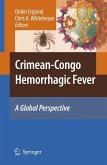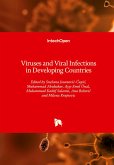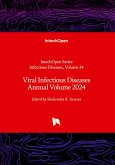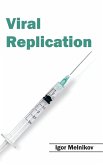Emerging and Re-Emerging Viral Diseases
Integrating Conventional and Complementary Treatment Strategies
Herausgeber: Goswami, Srijan; Choudhury, Moharana; Agarwal, Sangita
Emerging and Re-Emerging Viral Diseases
Integrating Conventional and Complementary Treatment Strategies
Herausgeber: Goswami, Srijan; Choudhury, Moharana; Agarwal, Sangita
- Gebundenes Buch
- Merkliste
- Auf die Merkliste
- Bewerten Bewerten
- Teilen
- Produkt teilen
- Produkterinnerung
- Produkterinnerung
This book examines the causative agents, pathophysiology, epidemiology, and clinical manifestations of Emerging and Re-Emerging Infectious Diseases. It explores conventional and complementary pharmacological strategies to combat these diseases.This book is intended for researchers and students of medical microbiology and infectious diseases.
Andere Kunden interessierten sich auch für
![Crimean-Congo Hemorrhagic Fever Crimean-Congo Hemorrhagic Fever]() Onder Ergonul / Chris C. Whitehouse (eds.)Crimean-Congo Hemorrhagic Fever115,99 €
Onder Ergonul / Chris C. Whitehouse (eds.)Crimean-Congo Hemorrhagic Fever115,99 €![The Role of Vitamins in Combating Infectious Viral Diseases The Role of Vitamins in Combating Infectious Viral Diseases]() The Role of Vitamins in Combating Infectious Viral Diseases131,99 €
The Role of Vitamins in Combating Infectious Viral Diseases131,99 €![Viruses and Viral Infections in Developing Countries Viruses and Viral Infections in Developing Countries]() Viruses and Viral Infections in Developing Countries84,99 €
Viruses and Viral Infections in Developing Countries84,99 €![Viral Infectious Diseases Annual Volume 2024 Viral Infectious Diseases Annual Volume 2024]() Viral Infectious Diseases Annual Volume 2024135,00 €
Viral Infectious Diseases Annual Volume 2024135,00 €![Viral Replication Viral Replication]() Viral Replication85,99 €
Viral Replication85,99 €![Human Antibody Therapeutics For Viral Disease Human Antibody Therapeutics For Viral Disease]() Scott DessainHuman Antibody Therapeutics For Viral Disease113,99 €
Scott DessainHuman Antibody Therapeutics For Viral Disease113,99 €![Viral Pathogenesis in Diagrams Viral Pathogenesis in Diagrams]() Hans-Wolfgang AckermannViral Pathogenesis in Diagrams94,99 €
Hans-Wolfgang AckermannViral Pathogenesis in Diagrams94,99 €-
-
-
This book examines the causative agents, pathophysiology, epidemiology, and clinical manifestations of Emerging and Re-Emerging Infectious Diseases. It explores conventional and complementary pharmacological strategies to combat these diseases.This book is intended for researchers and students of medical microbiology and infectious diseases.
Produktdetails
- Produktdetails
- Verlag: CRC Press
- Seitenzahl: 316
- Erscheinungstermin: 21. Juli 2025
- Englisch
- Abmessung: 260mm x 183mm x 22mm
- Gewicht: 792g
- ISBN-13: 9781032721798
- ISBN-10: 1032721790
- Artikelnr.: 72737350
- Herstellerkennzeichnung
- Libri GmbH
- Europaallee 1
- 36244 Bad Hersfeld
- gpsr@libri.de
- Verlag: CRC Press
- Seitenzahl: 316
- Erscheinungstermin: 21. Juli 2025
- Englisch
- Abmessung: 260mm x 183mm x 22mm
- Gewicht: 792g
- ISBN-13: 9781032721798
- ISBN-10: 1032721790
- Artikelnr.: 72737350
- Herstellerkennzeichnung
- Libri GmbH
- Europaallee 1
- 36244 Bad Hersfeld
- gpsr@libri.de
Srijan Goswami, an author and editor of several medical science books, is pursuing Ph.D. in Biotechnology from the Department of Biotechnology, University of North Bengal, India. He is a physician of biochemic system of medicine and also holds a specialization in Medical Biotechnology and Clinical Nutrition. He received his professional training on Community Nutrition and Child Care, Medical Microbiology, Medical Biochemistry, and Diabetes Counseling from reputed medical colleges in Kolkata, India. He has taught at several paramedical and lifesciences departments of reputed colleges and institutions. He is presently associated as Research Coordinator, Biomedical Research and Allied Sciences Division, Voice of Environment, Assam, India. Dr. Goswami has around 11 years of experience in the field of teaching and research and has published over 5 books (+8 in the pipeline) and ~40 research papers in national and international journals. He has independently and successfully guided around ten undergraduate and postgraduate students in their research work in the past three years. Dr. Goswami has received four Letters of Commendation for Global Community Services and Certificate of Honor for his contribution to the field of Science and Knowledge from the International Journal of Agricultural Research, Sustainability and Food Sufficiency (IJARSFS), International Journal of Advances in Medical Sciences and Biotechnology (IJAMSB), and International Journal of Health, Safety and Environment (IJHSE) in 2019, 2020, 2021, and 2023, respectively. The Current Research in Nutrition and Food Science (Enviro Research Group) and Academia Scholarly Journals have awarded him the Certificate of Excellence as Reviewer in 2020, 2021, and 2023. He is actively associated with the Editorial Review Board of 15 international journals. Sangita Agarwal is working as Associate Professor in the Department of Applied Science at RCC Institute of Information Technology, Kolkata, West Bengal, India. She completed her B.Sc. in Chemistry in 1992 from the University of Calcutta, West Bengal, and M.Sc. in Biochemistry in 1994. She obtained her Ph.D. degree in 2001 from Jadavpur University, West Bengal. She was a project participant in the Indo-Hungarian Exchange program under DST, New Delhi, in 1998-1999. She has eight years of full time postdoctoral research experience in various capacities and teaching experience of 13 years. She worked as Visiting Academic in Monash University, Melbourne, Victoria, during April-September 2008, under the Endeavour fellowship, sponsored by the Government of Australia. She is also the recipient of DST Women Scientist fellowship, sponsored by the Government of India, during 2009-2012. She also worked as Visiting Faculty for the Government College of Engineering and Ceramic Technology as well as MSIT, Kolkata. She has to her credit more than 50 scientific research papers and articles, 3 books, and more than 10 book chapters on health, toxicity, pharmacokinetics, environmental science, and environmental biology. She is Life Member of the Indian Chemical Society. Moharana Choudhury is an Indian researcher and environmentalist. He is a Researcher Coordinator in the Environmental Research and Management Division, Voice of Environment (VoE), Guwahati, Assam, India. Choudhury has worked on various scientific projects across multiple government departments and has more than 14 years of research and working experience in environmental research and services. He began his career as a research intern at the National Institute of Disaster Management in New Delhi, followed by the North Eastern Space Application Center (Department of Space, Government of India/ISRO Unit) as a Junior Research Fellow. Choudhury has authored or edited more than ten books with internationally reputed publishing houses and more than 40 articles in national and internationally reputed journals, proceedings, and more than 35 book chapters. He has written many articles and scientific reports in popular magazines. He has been working as an editor and reviewer of various prestigious international publishing houses worldwide, such as Elsevier, Royal Society of Chemistry (RSC), Springer, Wiley, CRC Press/Routledge group, Apple Academic Press, Cambridge Scholar Publishing, etc. Choudhury is working on various environmental conservation activities in Assam and throughout the country. He has worked on several initiatives to integrate environmentally sustainable projects for iconic heritage places, wetlands, and ecotourism spots in Assam, India, especially for cleanliness and beating single-use plastic pollution missions. He contributes to various environmental research, management, social media mass awareness, and research studies. He is also well known in India for his efforts to implement environmental education and safeguard the privileges of environmental degree holders in India. He has completed his education as an MSc, PGDGIS, PGDEM, and PGCGARD from Gurukul Kangri Deemed to be University, Haridwar, Uttrakhand, North Eastern Hill University (NEHU), Shillong Meghalaya, Tezpur University, Assam, and National Institute of Rural Development Panchayati Raj (NIRDPR) Hyderabad, Telangana, India, respectively. Sangita Agarwal is working as Associate Professor in the Department of Applied Science at RCC Institute of Information Technology, Kolkata, West Bengal, India. She completed her B.Sc. in Chemistry in 1992 from the University of Calcutta, West Bengal, and M.Sc. in Biochemistry in 1994. She obtained her
Chapter 1 Introduction to Emerging and Re-Emerging Infectious Diseases
(EID-REID)
Chapter 2 Infectious Hemorrhagic Fevers: The Crimean-Congo Hemorrhagic
Fever Orthonairovirus (CCHFV)
Chapter 3 Infectious Hemorrhagic Fevers: Rift Valley Fever Virus (RVF)
Chapter 4 Re-Emerging Zoonotic Viruses: Lassa Fever Viruses and Nipah
Viruses
Chapter 5 Filoviridae: Ebola Virus and Marburg Virus
Chapter 6 Coronaviruses: MERS-CoV, SARS-CoV, and SARS-CoV-2
Chapter 7 Mosquito-Borne Viral Infections: Chikungunya, Dengue, and Zika
Virus
Chapter 8 Pharmacological Strategies and Investigational Drugs for Emerging
and Re-Emerging Diseases of Viral Origin
Chapter 9 Treatment Strategies for MERS, SARS, and COVID-19
Chapter 10 Vaccine-Based Approaches for Emerging and Re-Emerging Viral
Diseases
Chapter 11 Clinical Examination, Immunoassays, and Molecular Diagnostic
Techniques for Emerging and Re-Emerging Diseases of Viral Origin
Chapter 12 Preventive and Social Medicine in Managing Emerging and
Re-Emerging Diseases of Viral Origin
Chapter 13 Emerging and Re-Emerging Viral Diseases: Perspectives from
Ayurvedic System of Medicine
Chapter 14 Emerging and Re-Emerging Viral Diseases (Influenza-Like
Illnesses): Perspectives from Homoeopathic System of Medicine
Chapter 15 Emerging and Re-Emerging Viral Diseases: Perspective from
Holistic Medical Nutrition Therapy
Chapter 16 Role of Systems Biology in Emerging and Re-Emerging Viral
Diseases
Chapter 17 SARS, MERS, and COVID-19: Knowledge Mining through
Bioinformatics and Computational Biology
Chapter 18 Bioinformatics and Computational Biology-Based Approaches in
Research and Clinical Management of Dengue Fever
Chapter 19 Bioinformatics and Computational Biology-Based Approaches in
Research and Clinical Management of Emerging Viral Zoonoses (LHF-NiVF)
Chapter 20 Role of Bioinformatics in Emerging and Re-Emerging Infectious
Diseases: A Drug and Vaccine Development Prospective
Chapter 21 One Health Approach in EID-REID Mitigation: A Comprehensive
Review of Interactions
Chapter 22 The Impact of Balanced Diet in Managing Degenerative
Consequences of SARS-CoV-2 Infection
Index
(EID-REID)
Chapter 2 Infectious Hemorrhagic Fevers: The Crimean-Congo Hemorrhagic
Fever Orthonairovirus (CCHFV)
Chapter 3 Infectious Hemorrhagic Fevers: Rift Valley Fever Virus (RVF)
Chapter 4 Re-Emerging Zoonotic Viruses: Lassa Fever Viruses and Nipah
Viruses
Chapter 5 Filoviridae: Ebola Virus and Marburg Virus
Chapter 6 Coronaviruses: MERS-CoV, SARS-CoV, and SARS-CoV-2
Chapter 7 Mosquito-Borne Viral Infections: Chikungunya, Dengue, and Zika
Virus
Chapter 8 Pharmacological Strategies and Investigational Drugs for Emerging
and Re-Emerging Diseases of Viral Origin
Chapter 9 Treatment Strategies for MERS, SARS, and COVID-19
Chapter 10 Vaccine-Based Approaches for Emerging and Re-Emerging Viral
Diseases
Chapter 11 Clinical Examination, Immunoassays, and Molecular Diagnostic
Techniques for Emerging and Re-Emerging Diseases of Viral Origin
Chapter 12 Preventive and Social Medicine in Managing Emerging and
Re-Emerging Diseases of Viral Origin
Chapter 13 Emerging and Re-Emerging Viral Diseases: Perspectives from
Ayurvedic System of Medicine
Chapter 14 Emerging and Re-Emerging Viral Diseases (Influenza-Like
Illnesses): Perspectives from Homoeopathic System of Medicine
Chapter 15 Emerging and Re-Emerging Viral Diseases: Perspective from
Holistic Medical Nutrition Therapy
Chapter 16 Role of Systems Biology in Emerging and Re-Emerging Viral
Diseases
Chapter 17 SARS, MERS, and COVID-19: Knowledge Mining through
Bioinformatics and Computational Biology
Chapter 18 Bioinformatics and Computational Biology-Based Approaches in
Research and Clinical Management of Dengue Fever
Chapter 19 Bioinformatics and Computational Biology-Based Approaches in
Research and Clinical Management of Emerging Viral Zoonoses (LHF-NiVF)
Chapter 20 Role of Bioinformatics in Emerging and Re-Emerging Infectious
Diseases: A Drug and Vaccine Development Prospective
Chapter 21 One Health Approach in EID-REID Mitigation: A Comprehensive
Review of Interactions
Chapter 22 The Impact of Balanced Diet in Managing Degenerative
Consequences of SARS-CoV-2 Infection
Index
Chapter 1 Introduction to Emerging and Re-Emerging Infectious Diseases
(EID-REID)
Chapter 2 Infectious Hemorrhagic Fevers: The Crimean-Congo Hemorrhagic
Fever Orthonairovirus (CCHFV)
Chapter 3 Infectious Hemorrhagic Fevers: Rift Valley Fever Virus (RVF)
Chapter 4 Re-Emerging Zoonotic Viruses: Lassa Fever Viruses and Nipah
Viruses
Chapter 5 Filoviridae: Ebola Virus and Marburg Virus
Chapter 6 Coronaviruses: MERS-CoV, SARS-CoV, and SARS-CoV-2
Chapter 7 Mosquito-Borne Viral Infections: Chikungunya, Dengue, and Zika
Virus
Chapter 8 Pharmacological Strategies and Investigational Drugs for Emerging
and Re-Emerging Diseases of Viral Origin
Chapter 9 Treatment Strategies for MERS, SARS, and COVID-19
Chapter 10 Vaccine-Based Approaches for Emerging and Re-Emerging Viral
Diseases
Chapter 11 Clinical Examination, Immunoassays, and Molecular Diagnostic
Techniques for Emerging and Re-Emerging Diseases of Viral Origin
Chapter 12 Preventive and Social Medicine in Managing Emerging and
Re-Emerging Diseases of Viral Origin
Chapter 13 Emerging and Re-Emerging Viral Diseases: Perspectives from
Ayurvedic System of Medicine
Chapter 14 Emerging and Re-Emerging Viral Diseases (Influenza-Like
Illnesses): Perspectives from Homoeopathic System of Medicine
Chapter 15 Emerging and Re-Emerging Viral Diseases: Perspective from
Holistic Medical Nutrition Therapy
Chapter 16 Role of Systems Biology in Emerging and Re-Emerging Viral
Diseases
Chapter 17 SARS, MERS, and COVID-19: Knowledge Mining through
Bioinformatics and Computational Biology
Chapter 18 Bioinformatics and Computational Biology-Based Approaches in
Research and Clinical Management of Dengue Fever
Chapter 19 Bioinformatics and Computational Biology-Based Approaches in
Research and Clinical Management of Emerging Viral Zoonoses (LHF-NiVF)
Chapter 20 Role of Bioinformatics in Emerging and Re-Emerging Infectious
Diseases: A Drug and Vaccine Development Prospective
Chapter 21 One Health Approach in EID-REID Mitigation: A Comprehensive
Review of Interactions
Chapter 22 The Impact of Balanced Diet in Managing Degenerative
Consequences of SARS-CoV-2 Infection
Index
(EID-REID)
Chapter 2 Infectious Hemorrhagic Fevers: The Crimean-Congo Hemorrhagic
Fever Orthonairovirus (CCHFV)
Chapter 3 Infectious Hemorrhagic Fevers: Rift Valley Fever Virus (RVF)
Chapter 4 Re-Emerging Zoonotic Viruses: Lassa Fever Viruses and Nipah
Viruses
Chapter 5 Filoviridae: Ebola Virus and Marburg Virus
Chapter 6 Coronaviruses: MERS-CoV, SARS-CoV, and SARS-CoV-2
Chapter 7 Mosquito-Borne Viral Infections: Chikungunya, Dengue, and Zika
Virus
Chapter 8 Pharmacological Strategies and Investigational Drugs for Emerging
and Re-Emerging Diseases of Viral Origin
Chapter 9 Treatment Strategies for MERS, SARS, and COVID-19
Chapter 10 Vaccine-Based Approaches for Emerging and Re-Emerging Viral
Diseases
Chapter 11 Clinical Examination, Immunoassays, and Molecular Diagnostic
Techniques for Emerging and Re-Emerging Diseases of Viral Origin
Chapter 12 Preventive and Social Medicine in Managing Emerging and
Re-Emerging Diseases of Viral Origin
Chapter 13 Emerging and Re-Emerging Viral Diseases: Perspectives from
Ayurvedic System of Medicine
Chapter 14 Emerging and Re-Emerging Viral Diseases (Influenza-Like
Illnesses): Perspectives from Homoeopathic System of Medicine
Chapter 15 Emerging and Re-Emerging Viral Diseases: Perspective from
Holistic Medical Nutrition Therapy
Chapter 16 Role of Systems Biology in Emerging and Re-Emerging Viral
Diseases
Chapter 17 SARS, MERS, and COVID-19: Knowledge Mining through
Bioinformatics and Computational Biology
Chapter 18 Bioinformatics and Computational Biology-Based Approaches in
Research and Clinical Management of Dengue Fever
Chapter 19 Bioinformatics and Computational Biology-Based Approaches in
Research and Clinical Management of Emerging Viral Zoonoses (LHF-NiVF)
Chapter 20 Role of Bioinformatics in Emerging and Re-Emerging Infectious
Diseases: A Drug and Vaccine Development Prospective
Chapter 21 One Health Approach in EID-REID Mitigation: A Comprehensive
Review of Interactions
Chapter 22 The Impact of Balanced Diet in Managing Degenerative
Consequences of SARS-CoV-2 Infection
Index








